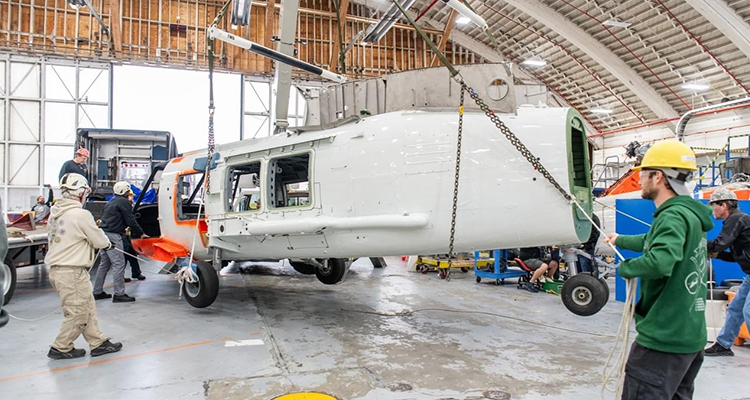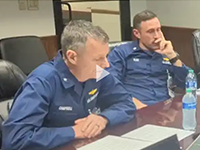Jan. 23, 2024 —

Aviation Logistics Center personnel position the first newly manufactured MH-60T hull into place following its delivery to the Elizabeth City, North Carolina, facility Dec. 9, 2023. The new MH-60T hulls will support service life extension program activities scheduled for the Coast Guard’s medium range recovery helicopter fleet and a future transition to an all MH-60T fleet. U.S. Coast Guard photo.
The Coast Guard received approval from the Department of Homeland Security on Oct. 31, 2023, to proceed with acquisition program activities that will continue to extend the service life of the existing MH-60T fleet as well as begin the Coast Guard’s transition to a rotary wing fleet consisting of all MH-60T aircraft. The MH-60T Acquisition/Sustainment Program is authorized to:
-
Move to full rate production of newly manufactured hulls as part of the service life extension program (SLEP) for the existing MH-60T fleet.
-
Conduct Obtain Phase activities and execute low rate initial production of 12 aircraft that will transition three Coast Guard air stations currently operating with the MH-65 to the MH-60T.
Consolidation of the Coast Guard’s rotary wing fleet to a single MH-60T airframe is necessary to mitigate sustainability challenges with the MH-65 short range recovery helicopter and maintain the service’s rotary wing capability until recapitalization in line with the Department of Defense’s Future Vertical Lift program.
The SLEP, now known as Increment 1 of the program, was established in 2017 to extend the service life of the 45 MH-60T aircraft currently in the fleet. These helicopters have been in service since 1990; without the SLEP, 90% of the MH-60T fleet would reach the end of its service life by 2028. To date, two aircraft have already completed SLEP activities.
The SLEP is extending the service life of the existing Jayhawk fleet through replacement of life-limited structural hulls, dynamic components and electrical wiring. All work is being completed by the Coast Guard Aviation Logistics Center (ALC). Because of specialized maintenance completed by ALC approximately every four years, the MH-60Ts that complete the SLEP will have between 12,000 and 20,000 hours of available service life once fielded.
The Coast Guard’s plan to organically grow the MH-60T fleet to at least 127 aircraft, referred to as fleet growth, will occur in two phases, using the same production activities completed in the SLEP. The first fleet growth phase, known as Increment 2 of the program, will organically produce 36 aircraft to convert eight air stations from MH-65 to MH-60T operations. The program has been authorized to produce the first 12 aircraft for this increment and will seek authorization from DHS to produce the remaining aircraft at a later date. Transition of the first air station under Increment 2 is expected to occur in summer 2024.
The air stations not transitioned to MH-60Ts under Increment 2 will be converted as part of Increment 3 of the program. The final air station transition is anticipated to occur in the early 2040s.
Hulls for the MH-60T Jayhawks for both SLEP and fleet growth will come from two sources, either newly manufactured hulls from the original equipment manufacturer, Sikorsky, or conversion of retired Navy hulls to the MH-60T configuration. On Nov. 30, the first newly manufactured MH-60T hull for the SLEP was accepted by the Coast Guard at the Sikorsky plant in Troy, Alabama. Delivery of hulls 2 and 3 is scheduled for early 2024. During full rate production, which starts with hull 4, deliveries should occur monthly. Forty-five new hulls are currently under contract.
The MH-60T is an all-weather medium range recovery helicopter capable of supporting multiple Coast Guard missions requiring rapid response and an extended on-scene presence. It also supports training and transporting cargo and personnel along with search and rescue, law enforcement, and environmental protection missions. It can reach speeds of around 200 mph and can be outfitted with a 7.62 mm machine gun and .50-caliber rifle designed to disable engines on noncompliant vessels as well as armor to protect crews from small-arms fire.
Related:

Video 1
Video 2
For more information visit: MH-60T Sustainment Program page